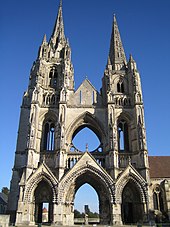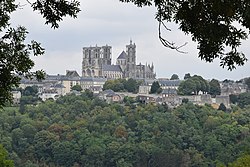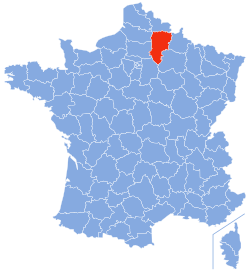|
Aisne
Aisne (/eɪn/ ayn,[3] US also /ɛn/ en;[4] French: [ɛːn] ⓘ; Picard: Ainne) is a French department in the Hauts-de-France region of northern France. It is named after the river Aisne. In 2020, it had a population of 529,374.[5] Geography The department borders Nord (to the north), Somme and Oise (to the west), Ardennes and Marne (east), and Seine-et-Marne (south-west) and Belgium (Province of Hainaut) (to the north-east). The river Aisne crosses the area from east to west, where it joins the Oise. The Marne forms part of the southern boundary of the department with the department of Seine-et-Marne. The southern part of the department is the geographical region known as la Brie poilleuse, a drier plateau known for its dairy products and Brie cheese. According to the 2003 census, the forested area of the department was 123,392 hectares, or 16.6% for an average metropolitan area of 27.4%.[6] The landscape is dominated by masses of rock which often have steep flanks. These rocks appear all over the region, but the most impressive examples are at Laon and the Chemin des Dames ridge. Principal towns The department of Aisne includes one medium-sized city (Saint-Quentin) and three small cities (Laon, Soissons and Château-Thierry) to which may be added the conglomeration formed by Chauny and Tergnier. There are many other agglomerations of an urban character because Aisne has been densely populated since before the 19th century. The villages are numerous and rather small. The most populous commune is Saint-Quentin; the prefecture Laon is the third-most populous. As of 2019, there are 7 communes with more than 10,000 inhabitants:[7]
See also: List of the communes of the Aisne department. Hydrography The Scheldt (which takes its source near Le Catelet), the Aisne, the Marne, the Ourcq, the Vesle, the Somme (which rises in Fonsommes), the Oise, and the Serre. In the south of the department, there is the Surmelin, the Verdonnelle, and the Dhuys (this river is channeled into the Dhuis Aqueduct, 131 km long, to supply drinking water to Paris since 1 October 1865 and also more recently the Leisure Park of Marne-la-Vallée). The department is also crossed by numerous canals (e.g. the Canal of Saint-Quentin, 93 km). ClimateThere is an average of 500 to 750 mm precipitation annually. Weather Data for Saint Quentin – Roupy
TransportRailwaysThe department is crossed by three railway lines from Paris: the first two from the Gare du Nord and the third from the Gare de l'Est:
In 1873, the department of Aisne had 10 railway companies with a total length of 382 km.[9] History Aisne developed from the ancient settlement of Acinum, from which its name derives.[10] The Battle of the Axona was fought nearby in 57 BC. Aisne is one of the original 83 departments created during the French Revolution on 4 March 1790. It was created from parts of the former provinces of Île-de-France (Laon, Soissons, Noyon, and Valois, which are actually historical and cultural parts of Picardy that were annexed to Île-de-France[11]), Picardy (Thiérache Vermandois), and Champagne (Brie, and Omois). Most of the old growth forests in the area were destroyed during battles in World War I. The French offensive against the Chemin des Dames in spring 1917 is sometimes referred to as the Second Battle of the Aisne. Heraldry
EconomyAgriculture dominates the economy, especially cereal crops. Beet sugar is one of the most important industrial crops of the area. Silk, cotton, and wool weaving flourish in Saint-Quentin and other towns. Saint-Gobain is known for its production of mirrors, which started in the 17th century. Guise is the agricultural centre of the northern area of Aisne. Volkswagen Group France has headquarters in Villers-Cotterêts.[12] PoliticsThe department is a mixture of rural areas and working-class towns. As a place of residence for some families working in Paris or Île-de-France, Aisne was for many years a department rather oriented to the left, with a majority on the General Council on the left since 1998, and the same for the majority of parliamentary seats representing the department in the National Assembly. However, since the 2000s, Aisne has strongly shifted in favour of the National Rally. Indeed, Aisne is the department that was most favourable to this party during the 2012 presidential elections, having won 26.33% of votes there.[13] In 2017, Aisne votes 52.91% in favour of the National Rally during the second round. In 2022, this value was 7 points higher, at 59.91%;[13] The smaller cities of the northern department such as Guise, Hirson, Vervins and the railway city of Tergnier are sources of support for left-wing parties. Departmental CouncilThe President of the General Council is the Liberal Nicolas Fricoteaux. In the 2021 departmental election, the Departmental Council of Aisne was elected as follows:[14]
Presidential elections 2nd roundIn the second round of the French presidential elections of 2017 Aisne was one of only two departments (along nearby Pas-de-Calais) in which the candidate of the Front National, Marine Le Pen, received a majority of the votes cast: 52.91%.[15] In the second round of the 2022 French presidential election, Aisne was the mainland departement with the highest percentage support for her.[16]
Representatives in the National AssemblyAdministrationAisne is divided into five arrondissements and 21 cantons. The department has 798 communes and five parliamentary constituencies. DemographyAisne lost some of its population in the second half of the 19th century, due to the rural exodus but this was limited by the industrial development in the north of the department (Saint-Quentin, Chaunois, Thiérache). Greatly affected by the First World War, the department has seen its population grow slightly to the same level as in 1900. For thirty years, the industrial decline has caused stagnation of the population (526,346 in 1968, 535,489 in 1999). Only the south-west of the department, close to the Paris conurbation, has seen much population growth. Population development since 1791:
Tourism     The boat tours relates in part to the Canal de Saint-Quentin with its electric towage and two tunnels (Lesdins and Riqueval/Vendhuile). In 2007, a large infrastructure for tourist accommodation, the Center Parcs, was built on the Lake of Ailette, close to many tourist attractions such as the Cathedral of Laon, the Chemin des Dames and the Château de Coucy. Among the many places to explore are:
In 2020, the department had 3.4% of second homes.[22] CultureDuring World War I a number of significant architectural monuments were destroyed. Of the buildings that survived, the medieval churches in Laon, Braine, and Urcel are the most significant. The ruined castle of La Ferté-Milon escaped further damage during the war. Of the castles that survived, some were used as prisons, such as the Castle of Vadancourt, near Saint-Quentin (500 prisoners).[23] It is thought that the Aisne River was the birthplace of the trench warfare seen in the First World War.[citation needed] The British Expeditionary Force (BEF) had initial early successes driving the Germans back to the Aisne River; the German troops dug in and managed to hold out against both British and French attacks. This German entrenchment was to mould the entire face of World War One as both sides began digging in and fortifying their positions.[citation needed] Thus began the stalemate that became a significant feature of the First World War. Languages
This linguistic variance probably explains the difficulty for residents south of Aisne to identify themselves as belonging to the Picardy region. Gastronomy
Notable people
See also
References
External linksWikimedia Commons has media related to Aisne.
|
|||||||||||||||||||||||||||||||||||||||||||||||||||||||||||||||||||||||||||||||||||||||||||||||||||||||||||||||||||||||||||||||||||||||||||||||||||||||||||||||||||||||||||||||||||||||||||||||||||||||||||||||||||||||||||||||||||||||||||||||||||||||||||||||||||||||||||||||||||||||||||||||||||||||||||




